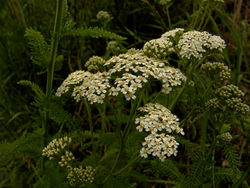Achillea millefolium
| See Also | Botanical Monographs |
|---|
Yarrow was once known as nosebleed, its feathery leaves making an ideal astringent swab to encourage clotting. It is a well known and versatile herb that is effective for its historical use of staunching bleeding and disinfecting wounds. It is also one of the best-known herbal remedies for fevers. To explore the characteristics, medicinal uses and prescribing considerations of this herb in more detail, check out the references indicated.[1] [2]
Contents
Characteristics
- Common Names: Yarrow
- Family: Compositae/Asteraceae
- Habitat: Achillea millefolium is native to Europe but has now also been naturalized in North America. It prefers fields and open areas.
- Parts Used: Flower (when blooming), 45% alcohol
- Constituents: Volatile oils (trace thujone, and many others), lactones, bioflavonoids, bitters, alkaloids, tannins, courmarins.
- Medicinal Actions: hemostatic, astringent, stomachic (gastric bitter), diaphoretic, diuretic, emmenagogue, stimulant, tonic, vulnerary, anti-inflammatory, anti-inflammatory gastrointestinal, bitter, carminative, decongestant
Uses
Historical Uses:
Yarrow was once known as nosebleed, its feathery leaves making an ideal astringent swab to encourage clotting. It is a well known and versatile herb that is effective for its historical use of staunching bleeding and disinfecting wounds. It is also one of the best-known herbal remedies for fevers.
Medicinal Uses:
Internal
- Bleeding
- leucorrhea, menorrhagia with uterine spasms/pelvic pain
- painful cystitis
- liver dysfunction, poor digestion and assimilation
- Other Conditions
- atonia (relaxed) tissue with lots of discharge, fever, upper respiratory infection, joint pains
Topically
- Bleeding and Trauma
- use a poultice with pulverized fresh plant - plant, flowers, leaves - and apply locally
- Leucorrhea - douche
Prescribing Considerations
The information provided is intended to augment the treatment from a naturopathic doctor or other trained medical professional. Although most herbs are generally safe, it is recommended that you avoid self-prescribing especially when there is an underlying ongoing medical condition, if you are on any prescription medications or if you are pregnant or breastfeeding.
Formulations and Preparation
- Tincture - 50-60 drops three times daily
- Fluid extract - 5-30 drops three times daily
- Infusion with flowers - 1-5g/cup fresh, 30-60mL three times daily
- Fresh succus/juice - 3 tsp or 15mL daily
- Essential oil - 5 drops diluted
- Sitz bath - 100g flower/20L of water
Safety
The safety and prescribing considerations for this herb include:[3], [4]
- Generally regarded as safe.
- Side-effects are not generally seen.
- Caution: may increase hydrochloric acid production, therefore use a proton pump inhibitor when combining with an H2 antagonist; caution with anticoagulant therapy.
- Contraindicated in pregnancy due to its emmenagogue and abortifacient actions if the essential oil with thujone component is used. Allergic hypersensitivity to Asteraceae family.
- Drug-Herb Interactions not generally seen.
References
- ↑ Boon Heather, Smith Michael (2009) 55 Most Common Medicinal Herbs: The Complete Natural Medicine Guide Second Edition Institute of Naturopathic Education and Research, CCNM Toronto.
- ↑ Godfrey Anthony, Saunders Paul, Barlow Kerry, Gowan Matt (2011) Principles and Practices of Naturopathic Botanical Medicine, Advanced Botanical Medicine. V3 CCNM Press, Toronto.
- ↑ Stargrove Mitchell Bebell, Treasure Jonathan, McKee Dwight L (2008) Herb, Nutrient and Drug Interactions: Clinical Implications and Therapeutic Strategies.
- ↑ Brinker Francis (1997) Herbal Contraindications and Drug Interactions: Plus Herbal Adjuncts With Medicines, 4th Edition Eclectic Medical Publications.
